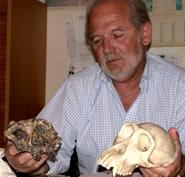 It's a lot of emotion to have in my hand the beginning of the human lineage. I have been looking for this for so long." Michel Brunet of the University of Poitiers, France© M.P.F.T.
It's a lot of emotion to have in my hand the beginning of the human lineage. I have been looking for this for so long." Michel Brunet of the University of Poitiers, France© M.P.F.T.After a decade of digging through the sand dunes of northern Chad, Michel Brunet found a skull 6-7 million years old. He named it Toumaï.
Toumaï is thought to be the oldest fossil from a member of the human family. It's a dispatch from the time when humans and chimpanzee were going their separate evolutionary ways. A thrilling, but confusing dispatch1,2.
Sahelanthropus tchadensis - Toumaï's scientific name - was probably one of many similar species living in Africa at that time. "There must have been a group of apes knocking around between 5 and 8 million years ago for which there's a very poor fossil record," says anthropologist Bernard Wood of George Washington University in Washington DC.
Toumaï is the tip of that iceberg - one that could sink our current ideas about human evolution. "Anybody who thinks this isn't going to get more complex isn't learning from history," says Wood.
"When I went to medical school in 1963, human evolution looked like a ladder," he says. The ladder stepped from monkey to man through a progression of intermediates, each slightly less ape-like than the last.
Now human evolution looks like a bush. We have a menagerie of fossil hominids - the group containing everything thought more closely related to humans than chimps. How they are related to each other and which, if any of them, are human forebears is still debated.
Most members of the group are less than three million years old. After Toumaï, the next-oldest hominid is the 6-million-year old Orrorin tugenensis. But Orrorin is known only from a few teeth and bone scraps, and its evolutionary allegiances are controversial.
Our knowledge of Toumaï's period is "at the 1963 stage", says Wood.
Feature story
"When I first saw the skull I thought: 'Gee, it's a chimp'," says anthropologist Daniel Lieberman of Harvard University. Toumaï's brain, for example, was roughly chimp-sized. A closer look "blew my socks off", he recalls.
Sahelanthropus has many traits that shout 'hominid'. These include smaller canines, and thicker tooth enamel than apes. And the point at the back of skull where neck muscles attach suggests that Toumaï walked upright.
Many of Toumaï's advanced features are missing from later fossils such as Australopithecus, but reappear in still later species that are classified as Homo.
 Finding hominids in the Sahara was a bit of a long shot.© M.P.F.T.
Finding hominids in the Sahara was a bit of a long shot.© M.P.F.T.Based on this, we might have to question some species' place in the hominid club. If Australopithecus looks more ape-like than a much older fossil, how can it belong to the human family? "Anything with a more primitive face has to have its membership reviewed," says Wood.
No groups will be expelled on the evidence so far. The real lesson, says Wood, is that appearances are a bad guide to evolutionary relations. Hominid and ape species probably mixed and matched from a set of features, he says, with the same traits evolving independently on multiple lineages.
Toumaï has other features that are just strange. "It's got a massive brow ridge, the size of a large male gorilla, and yet it's just a little hominid," says Lieberman. This heavy brow leads many to believe that Toumaï was male.
Family feud
Where then does Toumaï fit on the family tree? He could belong on the chimp or hominid lines, or he could be part of a different branch of the family, more distant from both chimps and humans that either is from the other.
"I'm willing to bet some money that this is a hominid," says Lieberman.
Palaeoanthropologist Tim White of the University of California, Berkeley, agrees. He thinks that Toumaï might belong to Ardipithecus, a group defined by fossils dating from about 5.5-4.5 million years ago.
“I'm willing to bet some money that this is a hominid”
Daniel Lieberman
Harvard University
But Wood takes a different view. "My guess is that it's neither a chimp nor a human ancestor - it's a creature that was living at the same time."
To solve the mystery we need more fossils from the same period. Unfortunately our relatives' habits may be against us. The forests favoured by chimps, and apparently by early hominids, are not conducive to fossil formation. Chimps, for example, have no fossil record.
On the bright side, Toumaï's discovery suggests that, even if they were rarely fossilized, ancient apes and hominids roamed right across Africa. "Finding hominids in the Sahara was a bit of a long shot," says Wood. So far, most fossil hominids have turned up in the east, with a few further south.
But desert-bound palaeontologists be warned: "There are brutal field conditions," says Lieberman.
-
References
- Brunet, M. et al. A new hominid from the Upper Miocene of Chad, Central Africa. Nature 418, 145 - 151 (2002). | Article | ISI | ChemPort |
- Vignaud, P. et al. Geology and palaeontology of the Upper Miocene Toros-Menalla hominid locality, Chad. Nature 418, 152 - 155 (2002). | Article | ISI | ChemPort |
